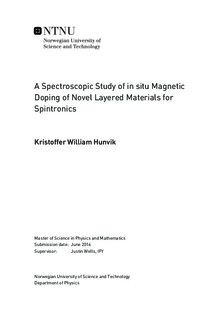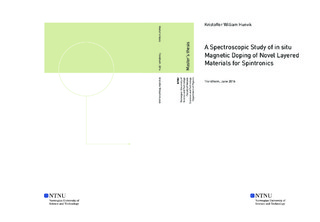| dc.description.abstract | MoS2 is a layered material in the family of the transition metal dicalchogenides (TMDCs), which hosts interesting spin physics. Even though the TMDCs are nonmagnetic in their bulk form, a local breaking of inversion symmetry combined with a strong in-plane dipole and a strongly localized character of the electron wavefunctions, causes the TMDCs to show highly anisotropic spintronic properties. In this work the effects of in situ evaporation and annealing of iron on the surface of MoS2 are studied by the means of X-ray Photoemission Spectroscopy (XPS), Low Energy Electron Diffraction (LEED) and Angle Resolved Photoemission Spectroscopy (ARPES). This is to understand how to grow model systems to allow magnetic impurities and magnetic fields to influence the electronic properties of MoS2. This is done by growth of thin films on MoS2 and attempting intercalate iron into the crystal structure of MoS2.
The results show that it is possible to grow fairly homogeneous films of iron on the surface of MoS2, which cause band bending in the valence band and core levels of 0.41±0.07 eV towards lower binding energy. The iron on the surface creates a flat band at the Fermi level, suggesting together with weaker intensity in the LEED measurements that the iron is not forming any ordered structure on the surface. By counterdoping with potassium the band bending from the iron is reduced such that the core levels return to their initial position. The results show that intercalation at room temperature is unlikely. Angle resolved XPS (ARXPS) data has been acquired and modelled by using a multilayer model and a model for agglomeration/intercalation. With the sample annealed to 400°C with potassium and iron on the surface, the data and the two models suggest that the iron could be intercalating with some iron left on the surface. With the sample annealed to 500°C with iron on the surface, the models disagree. The multilayer model suggests intercalation within the first two unit cells of the crystal and the other suggests 3D particle growth.
A preliminary low temperature ARPES study shows that for lower doses of iron the semiconducting behaviour of MoS2 is preserved. For half a monolayer of iron on MoS2, the valence band shifts towards lower binding energy by 0.12 eV suggesting n-doping. The n-type doping could be due to inhomogeneous band bending or iron-carbide forming on the surface. For another sample with 0.1 nm of iron, the two original bands at K-point split into four bands, which could originate from an electrical potential and/or magnetic effect due to iron on the surface.
The results in this work provide a good foundation for further studies on the influence from magnetic impurities on these layered materials, to pave the way for spintronics for a new generation of multifunctional electronic devices. | |

